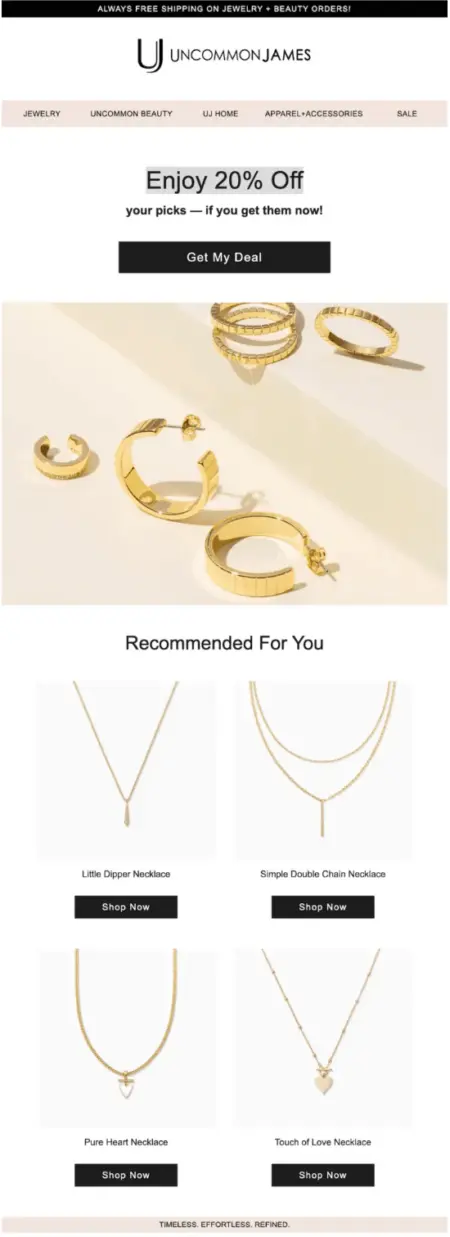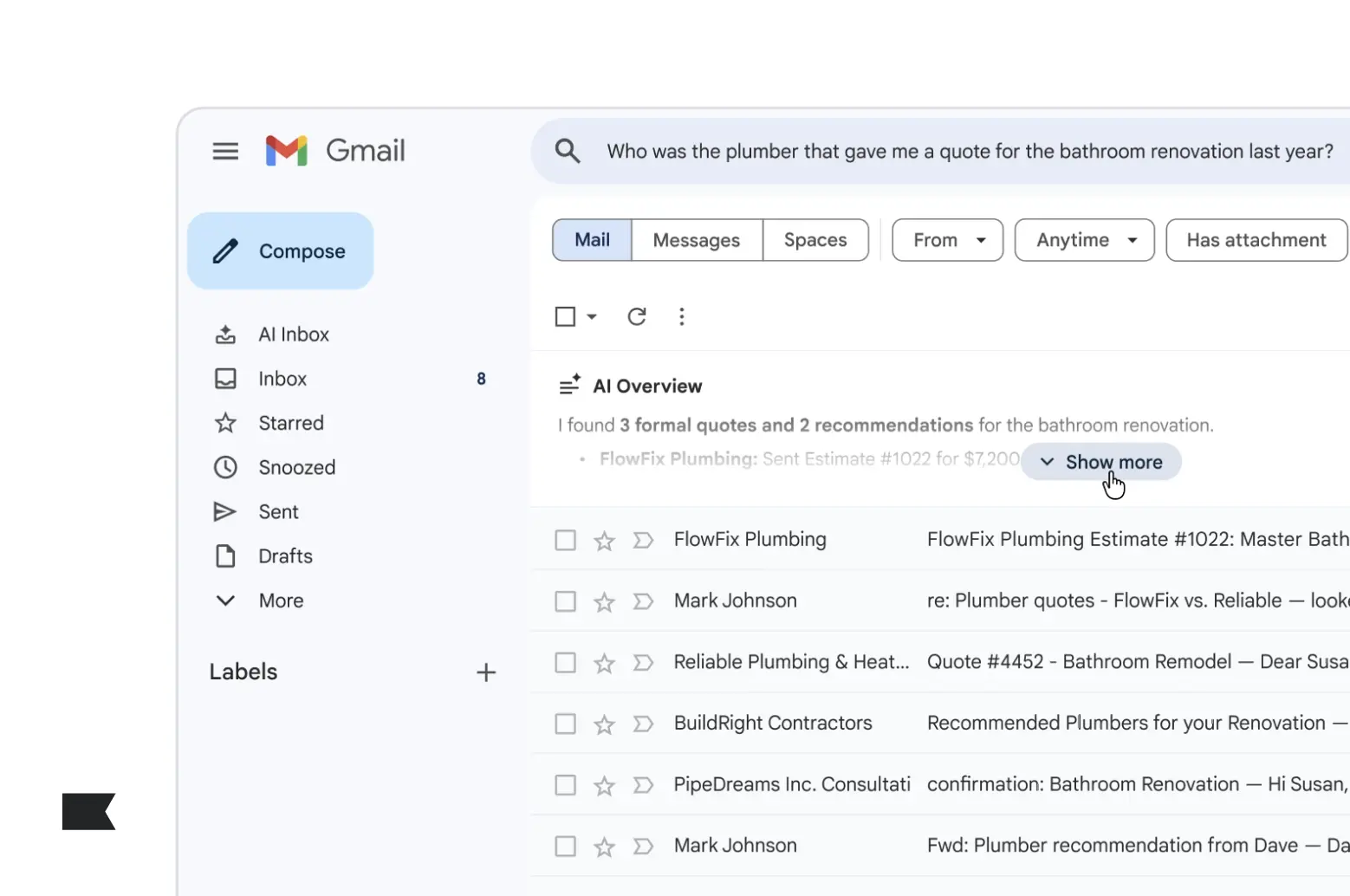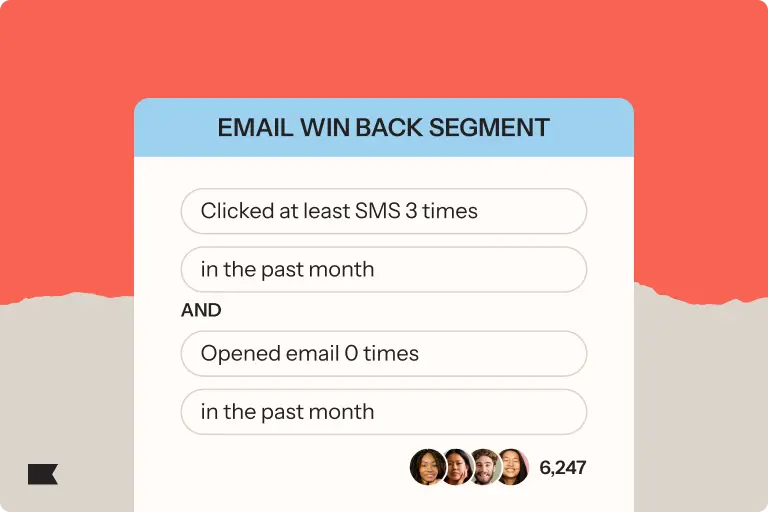How to grow your business with email marketing automation

The first mass email promotion generated $12M in sales, but it didn’t win any hearts and minds.
In 1978, Gary Thuerk, marketing manager at Digital Equipment Corp, used ARPAnet (an internet precursor) to invite 400 people to a demo for a product called DECsystem-20T.
While the first mass promotion email was a massive success, generating $12M in sales ($54.6M today), it also made people angry—because they never asked to receive it.
In an interview, Thuerk explained, “My boss congratulated me for the sales, but 5 days later, he made me promise that I would never do it again.”
We’ve come a long way since the unsolicited emails of ‘spray and pray’ email marketing. Now, with email automation, brands are messaging people who actually want emails—but it’s a privilege brands should handle with care.
We’ve come a long way since the unsolicited emails of “spray and pray” email marketing. Now, with email automation, brands are messaging people who actually want emails. Using email marketing automation techniques, brands can deliver highly personalized, timely messages that resonate with their audience, fostering deeper relationships and driving long-term engagement.
What is email marketing automation?
Email marketing automation refers to messages a brand sends to people at scale, typically according to common online behaviors such as subscribing to a list or browsing a website.
Email automation technology is what enables you to build personalized content and rules around which emails go out, and when—without manually adding people to a recipient list or pressing send.
In other words, email automation allows you to make money from your email marketing strategy in your sleep. Automated email campaigns work seamlessly in the background to nurture leads, convert customers, and keep your brand top of mind.

What’s the difference between email automation and an email campaign?
Automated emails are based on behavioral triggers, whereas email marketing campaigns are delivered in manual, one-time batches for a specific promotional goal. Based on Klaviyo data, automated emails drive over 16x higher revenue per recipient (RPR) than manual campaigns.
Automated emails drive over 16x higher revenue per recipient (RPR) than manual campaigns.
When you set up an automated email series, or flow, you’re developing content around a specific person’s interactions with your brand, like subscribing to an email list, browsing your website, putting items in a cart, or purchasing an item. Email automation workflows don’t require much effort to maintain—and your customers get a highly personalized experience.

By contrast, when you set up an email campaign, you’re probably sending a batch of emails to promote a sale or announce a new product. On Black Friday, for example, you might send an automated email campaign to predetermined segments of your owned audience, with an initial touchpoint and follow-ups until the campaign is over.
Core email automation basics to implement into your email campaigns
First, know this: There’s a lot of room for creativity with email automation throughout the customer journey.
What works for one brand may flop for another. You may find yours deviates from the basics—but it’s important to put a strong foundation in place.
“Get the fundamentals dialed in before attempting to build more advanced automations,” advises Ryan Turner, founder of Ecommerce Intelligence. “There are a lot of complex automations you can build, but focusing on the basics like your welcome email series, abandoned cart flow, and post-purchase sequence first is key.”
“Those are most often the biggest revenue drivers and you can go a long way with those campaigns alone,” Turner adds. “Don’t be tempted to build out everything in the first few weeks or months. Invest in creating the best possible versions of the basic higher-volume email automations, then expand into more advanced sequences once they’re performing well.”
Invest in creating the best possible versions of the basic higher-volume email automations, then expand into more advanced sequences once they’re performing well.
The catch is that you won’t be the one to decide what your ecommerce email automations should look like. Your audience will.
Before your email automations are “set in stone” (they never really are), get to know your audience by:
- Interviewing your ideal customer
- Asking loyal and engaged customers for creative feedback
- A/B testing a lot of creative concepts against each other (more on this later)

Through feedback and trial and error, you’ll be able to build on the basics we describe below in a way that works for your brand. But if you need a place to start, use this tried-and-true framework:
Welcome series emails
Welcome series emails are the first interaction your brand has with someone via email, most commonly after they sign up for your newsletter.
The purpose of your welcome series is to introduce people to your brand, educate them about your industry and products, and nudge them toward taking an action (like buying!).
Automated welcome emails perform at 4x the click rate and 23x the conversion rate of non-automated email campaigns, according to Klaviyo benchmarks.
The 4 most common types of welcome emails in an email automation campaign are:
- Brand story: Your goal here is to share your mission and values to build trust.
- Thank you: Your goal here is to show appreciation to create future goodwill.
- Conversion: Your goal here is to encourage action to convert new subscribers to new customers.
- Getting started: Your goal here is to familiarize email subscribers with your products to show how your brand adds value.

Of course, most welcome emails overlap in their goals. Check out this example from Fly by Jing:

Fly by Jing’s email accomplishes 3 goals:
- Describes product value: “Where highly charged flavors meet 100% real ingredients.”
- Humanizes the brand founder: “I founded Fly by Jing in 2019, inspired by the amazing flavors of my hometown Chengdu and its famous fly restaurants…”
- Clarifies brand values: “Fly by Jing doesn’t conform to anyone else’s notions of value, taste, tradition.”
Abandoned cart email series
Abandoned cart emails are exactly what they sound like—they’re the email that goes out to someone who’s abandoned their online cart after placing an item in it.
Abandoned cart email flows generate average revenue of $3.58 per recipient—the highest across all email automation campaigns and flows, according to Klaviyo benchmarks.
The main goal of an abandoned cart email is to encourage the cart abandoner to complete their purchase. But here, we’ll break down an alternative—and often overlooked—approach from Uncommon James:

Uncommon James’ abandoned cart email is thoughtful because they put themselves in the shoes of their audience. When we break down their line of thinking, it looks something like this:
- The customer didn’t decide to purchase the item.
- Uncommon James’ offers products that are similar to each other, but with some distinct differences.
- The customer may feel confused about what they want.
- Uncommon James sends them a list of product recommendations based on the item the shopper added to their cart.
The bottom line: “The customer didn’t purchase the original product for a reason. Let’s show them some other options they might like more.”
Abandoned cart emails don’t need to be one-offs, either. If you want to incorporate a discount code as an incentive but don’t want to lead with it, you can build a series of emails like this:
- Email 1: Remind customers what they left in their shopping cart. If they don’t buy, send…
- Email 2: A follow-up email with a discount code. If they still don’t buy, send…
- Email 3: A customer testimonial or how-to video embeded in an email—because the customer might need more education.
Browse abandonment email series
A browse abandonment email is the ninja version of the abandoned cart email. It’s the automated email that sends when one of your subscribers or previous customers browses a product page for a certain amount of time but leaves without purchasing.
The more someone lurks, the more powerful the browse abandonment email automation. That’s why some brands trigger them only when people return to their website a certain number of times.
Alexa Engelhart, VP of client strategy for Power Digital Marketing, gives some great advice around browse abandonment email automations: “Think about what the user did not see on your product detail page that caused them to hesitate and not add to cart. This could be more information on ingredients, fit guides, use cases, etc.”
Think about what the user did not see on your product detail page that caused them to hesitate and not add to cart.
This is what Neptune does with their browse abandonment email:
- Highlights the product’s comfort, breathability, and adjustability.
- Details features including the memory foam and aromatherapy pouch.
- Introduces an ideal outcome where customers get the best sleep of their life.

To dot the I’s and cross the T’s on your strategy, read our guide on browse abandonment email subject lines.
Post purchase email series
Post-purchase emails are a beautiful thing—because they mean someone has already purchased one of your products.
Many of these emails are simple and transactional, like order confirmation emails and shipping confirmation emails. But you can also use marketing emails to enhance the customer experience by educating people about what they just bought—and preventing buyer’s remorse.
Post-purchase emails have some of the highest open rates at a 61% average, according to Klaviyo benchmarks. That makes sense—you’re catching people at their most engaged, which is why post-purchase emails are a great tool for encouraging repeat purchases and instilling brand loyalty.
But keep in mind the need to balance what you want—repeat purchases—with what the customer wants—a good post-purchase experience. Post-purchase emails focused on loyalty programs and up-selling should come after standard transactional emails that build trust.

If you’re wondering what a good educational post-purchase email looks like, check out this example from Dossier:

Dossier’s email builds trust and credibility by:
- Acknowledging that perfume is a luxury purchase and therefore requires special care
- Providing 4 tangible actions customers can take to preserve the quality of their purchase
- Driving people to a more detailed piece on perfume care, which shows they know their stuff
But after the education comes the next part in the series: incentives to buy again.
According to Hannah Spicer, director of Hannah Spicer Consulting, that second purchase is key. “Include an incentive for first-time purchasers to drive their second purchase,” she suggests. “Once a customer has shopped with you twice, they are more likely to shop with you a third, fourth, fifth time.”
Once a customer has shopped with you twice, they are more likely to shop with you a third, fourth, fifth time.
Win-back email
A win-back email may be less celebratory than a post-purchase email, but it’s almost as important. It’s the type of email automation that is sent to “win back” engagement from a subscriber or customer who hasn’t purchased from or interacted with your brand for some time.
Win-back emails are important because it’s a lot of work (and money) to convert a new shopper in the first place—especially considering experts have estimated customer acquisition costs have increased by as much as 60% in the last 5 years. So it’s worth the effort to win them back with re-engagement email campaigns—and increase their lifetime value.
“A lot of brands already know they are leaving money on the table by not fully addressing the customer lifecycle and having solutions for efficient repeat purchasing,” points out Andrew Rosensweig, strategist at Electric Eye. “It’s important to at least start somewhere, get data, learn, and iterate to improve the tailored messaging that will effectively cultivate repeat buyers.”
A lot of brands already know they are leaving money on the table by not fully addressing the customer lifecycle and having solutions for efficient repeat purchasing.
Depending on the length of your average sale cycle—time from first engagement to a sale—a customer is considered inactive after 3-6 months of radio silence. In this case, “engagement” means either making a purchase, interacting with an email, or visiting your website.
While the contents of a standard win-back email are usually made up of a goodbye, a promise not to contact again if there’s no re-engagement, and an incentive, this example from Printfresh lands on a winning combination: an incentive plus some novelty.

Printfresh’s headline, “See what’s new,” isn’t a goodbye—it’s an invitation for a fresh start. The novelty coupled with the discount incentive is a great way to remind people about benefits and features other people love.
Put it into play: how to set up an email marketing automation
Now that you know about email automation content, we’ll guide you through some of the more technical aspects of setting up and running email automations.
The beauty of marketing automation tools is that they don’t require technical skills to operate—most of them are “no code” tools that allow you to plug in content and manipulate various parameters for audience segmentation, testing, and delivery.
Here’s a basic step-by-step guide on how to implement an email marketing automation:
1. Choose a pre-built email automation flow from a goal library
Most email automation platforms are masters of their craft—they have data on what works best, and they’re able to segment that customer data into email automation goals. You should be able to select a pre-built email automation flow from a goal library, which eliminates the need to start from scratch.
Klaviyo, for example, lets you browse by goal, which is helpful if you already have some basic flows set up. If you don’t, there’s a “Start with the essentials” flow so you can set up what we described above.

2. Choose your trigger and flow filters
Every action has a reaction. Same goes for email automations, which are based on behavioral triggers. Here’s what you’ll likely be choosing from:
- List-triggered: People qualify to enter a list-triggered flow when they’re added to a specific list, like a welcome series.
- Segment-triggered: People qualify to enter a segment-triggered flow when they’re added to a specific segment, like a “loyal customers” segment.
- Metric-triggered: People qualify to enter a metric-triggered flow when they take a specific action, like placing an order.
- Date property-triggered: People qualify to enter a date property-triggered flow based on dates in their personal profile, like a birthday.
- Price drop-triggered: People qualify to enter a price drop-triggered flow if an item they viewed or started check-out with drops by a certain amount or percent.
3. Add steps to a flow
After choosing behavioral triggers and flows, it’s time to match them with an action. Here’s what you’ll specify when you get to this stage:
- Action: the specific task to perform, like sending an email or updating information on a profile
- Timing: a time delay before the stated action, usually relative to another action associated with someone’s profile
- Logic: usually expressed as an “if/then”; you can specify parameters that dictate whether or not an action is taken, to split your audience into segmented lists
4. Schedule a step in a flow
Email automation means you’re setting people up to move through flow steps sequentially, starting with the behavioral trigger and moving toward other steps.
That means things can get complicated. When you’re sending multiple messages based on multiple behaviors, time delays become important to keep your email automation well-paced and customer-friendly.
For example, a 24-hour (or longer) delay between your first email and your second email in a welcome series flow gives the recipient enough time to read the first email before receiving another.
5. Set the flow action status
Once your set-up is complete and you’re ready to turn on your email automation flow, set the flow action status. After you double check all your parameters, you’ll likely be able to toggle your flow from “draft” to “live.”
How important is choosing the right email automation tools?
It is important to consider various aspects when selecting any email marketing automation software. Choosing the right email automation tools can be very important for businesses that rely on email marketing automation to drive sales and engagement. Email automation tools allow you to streamline your email messages and campaigns, saving time and effort while increasing your email open and email click-through rates. Some benefits of choosing the right email automation tools include:
- Time savings: When you automate email tasks, like sending follow-ups or promotions, it frees up time for other efforts.
- Personalization: Tailoring your email campaigns based on customer behavior and preferences increases relevance.
- Increased engagement: Sending timely, relevant automated emails leads to higher open and click-through rates.
- Improved email workflows: A well-organized email automation system streamlines your processes for greater efficiency.
- Improved analytics: With email marketing automation tools, you can track key metrics such as open rates and conversions to refine your campaign.
What are the top email automation features to look out for?
Here are some of the top email automation features to look out for:
Segmentation and personalization
The ability to segment your email list based on customer behavior, interests, and demographics is a key aspect of email marketing automation. This can help you send more targeted and personalized messages, leading to higher open and click-through rates.
Automation workflows
Look for an email automation tool that offers a range of automation workflows that can be triggered based on specific actions or behaviors, such as welcome emails, abandoned cart reminders, or post-purchase follow-ups. This makes running automated email campaigns easier and more effective.
A/B testing
A/B testing allows you to test different elements of your email campaigns, such as subject lines or call-to-actions, to optimize your campaigns for higher open and click-through rates. Testing these elements is essential for optimizing email marketing automation strategies and helps you determine the best-performing versions of your emails to improve open and click-through rates.
Reporting and analytics
The best email marketing software should offer real-time reporting and analytics capabilities, allowing you to track key email marketing metrics such as open rates, click-through rates, and conversion rates.
Integration with other tools
Look for an email automation tool that integrates with other marketing channels and tools you use, such as your ecommerce CRM or e-commerce platform, to streamline your email marketing automation strategy.
Responsive design
Ensure that your email automation tool offers responsive design capabilities to ensure that your emails look great on all devices.
By looking for these key features in tools to automate email marketing, you can ensure that you’re choosing one that will help you create the best email campaigns, save time and effort, and ultimately drive better results for your business.
5 email automation tips for more engagement and revenue
The work doesn’t stop after you set up your email automations. We hope you feel confident with the basics by now, but we also want your email automations to thrive.
“Remember that an email strategy is never-ending. When first starting out, it can take months to build up enough data before you’re able to make smart decisions,” says Lisa Oberst, director of email marketing at Fuel Made.
“Don’t be afraid to test new messaging, designs, and campaign ideas, but also take the time to review your ideas later and evaluate their effectiveness,” Oberst adds. “Get your first attempts live, and continue testing and improving as you go.”
Get your first attempts live, and continue testing and improving as you go.
Here are 5 tips to set you up for success:
1. Prioritize email deliverability
Remember that first promo email we talked about at the beginning of this article? It likely wouldn’t have survived the email deliverability standards of today.
Email deliverability is the rate at which your emails make it past spam filters and into people’s inboxes. Email service providers like Gmail, Outlook, and iOS use algorithms to gauge the viability of an email based on factors like sender domain reputation, recipient engagement, and content.
Ensuring your automated email campaigns make it to the inbox is crucial for success. When you’re sending emails based on behavioral triggers, you’ve already done a lot of the work to make sure the recipient wants to hear from you—which is vital to ensuring healthy deliverability rates. But here are a few other ways to improve email deliverability with email automation:
- Keep clean email lists. If someone unsubscribes, honor their wishes and don’t continue to email them.
- Optimize your email content. Make sure your emails are mobile-friendly. Avoid spammy language.
- Consider a double opt-in process. When someone subscribes, ask them to confirm.
- Segment your email list. Split your overall list into segments to provide a personalized email experience.
- Monitor your email deliverability metrics. Keep an eye on unsubscribe rates and email bounce rates, to diagnose any deliverability issues early.
2. Start out strong with catchy subject lines
Subject lines are the first thing the recipient sees when your email lands in their overflowing inbox, so they need to be great.
But what does a “great” email subject line look like? Here are a few elements to experiment with in your email automation flows:
- Personalization: for example, using the recipient’s first name
- Brevity: Based on Klaviyo data, subject lines across all business sizes are on average 7 words long.
- Urgency or FOMO: Klaviyo research found that subject lines with one word in all caps, or language like “important” or “attention,” earn higher open rates.
- Piquing curiosity: for example, “Something new is coming…”
- Incentives: for example, discounts or special offers
Check out this great example from Supply, where the subject line considers context. They know their email lives inside an overflowing inbox, and they’re not afraid to say their email is better than what’s below it.

3. Use segmentation to increase relevance on a 1:many basis
Customer-First Data™—the combination of zero- and first-party data—refers to information the customer hands over voluntarily.
It’s also an essential component of audience segmentation, which is how brands split audiences into lists based on purchasing trends, website activity, email engagement, and customer service interactions.
Personalizing emails to behavior means tailoring content to:
- Website visitors: getting down to the product description page level
- Campaign engagers: people who open and click on certain emails over others
- Buyers: to increase average spend and repeat purchases
- App activity: to engage with your “stickiest” users
For example, when a subscriber views a product page or places an item in their cart, that’s information you can use to segment your list into “highly engaged” subscribers, then segment again by product type.
When you split audiences into niches like this, you increase the relevance of your email marketing automation messaging—and also the likelihood they’ll engage.
4. Leverage A/B testing to optimize performance
A/B testing is how you refine email performance, which is especially important when you’re starting from scratch and don’t yet know what works.
Some basic examples of A/B tests for email are:
- Testing subject lines for open rate performance
- Testing calls to action (CTAs) for click-through rate performance
- Testing images and layouts for click-through rate performance
The golden rule of email automation A/B testing is to test only one element at a time. If you’re testing subject lines, don’t test CTAs at the same time—the double variable will skew your results, and you won’t know what’s responsible for an improvement or drop in performance.
With Klaviyo, you can customize your A/B test parameters by audience percentage and time.
For example, you can choose to reserve 20% of your email recipients for variation A, and another 20% for variation B. Depending on how many of your recipients click on the email, a winner emerges after 6 hours—and the rest of the recipients automatically receive the winning variation.
5. Use email design to leave a lasting brand impression
What qualifies as “good” email design?
Basically, it’s anything that conveys your message quickly and entices people to click on your email. While some brands hire designers to design their email templates, others use platforms like Canva.
Your basic email template looks something like this:
- Heading
- Hero image
- A short blurb
- CTA button
You may want to deviate from this template because you want to include more product shots, or you want to test a CTA button near the top. Your options are plentiful, but we recommend adhering to some basic email design principles as you get your email marketing automation strategy up and running:
- Include your logo.
- Include your social media links.
- Include an unsubscribe link at the bottom—it’s the law.
- Use images, but don’t stuff your email with so many that it can’t load quickly.
- Experiment with colorful or patterned backgrounds.
- Don’t include more than 3 CTAs.
- Always optimize for mobile—odds are, this is how people will view your email.
Email automation is a foundation to build on
We’ve given you the basics of email automation and a great place to start. But you’ll be the one to make your email automations shine.
“Keeping it simple will be a benefit when first starting out,” says Cassie Benjamin, email and SMS channel manager at Tadpull. “As you get your feet wet with automation, you can begin to build out your flows to better personalize your messaging and strategy based on customer attributes and behavior.”
As you get your feet wet with automation, you can begin to build out your flows to better personalize your messaging and strategy based on customer attributes and behavior.
Get the most out of your owned channels with Klaviyo, which comes with all the email automation essentials for your business.
Email automation FAQs
How does email automation work?
Email automation is the use of technology to automatically send emails in response to a user’s behavior. For example, you can automate a welcome email series to someone who subscribes to your email list for the first time. Well-built email automations are very useful for marketers to nurture relationships with potential customers and increase sales.
Is email marketing automation effective?
Yes, email marketing automation is an effective way to use customer behavior insights to deliver a good customer experience, all while saving brands time and scaling customer communications. Done right, automated email marketing tools can have a huge impact on brand awareness, loyalty, and revenue growth.
Which businesses should use email marketing automation software?
Any business that relies on email marketing to communicate with its customers, prospects, or donors can benefit from using email marketing automation software to streamline their campaigns and increase engagement. Email marketing software can be beneficial to both large and small businesses including e-commerce businesses, B2B businesses, service-based businesses, and non-profit organizations.
What are the main benefits of email automation?
Email automation is a marketing tactic that helps brands:
- Nurture customer relationships
- Improve customer retention
- Boost brand awareness
- Increase sales
- Maximize revenue

Related content

Google is bringing Gemini AI directly into Gmail, changing how emails are summarized, prioritized, and acted on. Here’s what retail marketers need to know—and how to adapt.

Discover the best email marketing platform for ecommerce in 2026. Compare top tools for data, automation, personalization, and deliverability.

Learn how to use Klaviyo SMS, segmentation, and hybrid flows to re-engage lapsed email subscribers, boost deliverability, and drive higher retention.